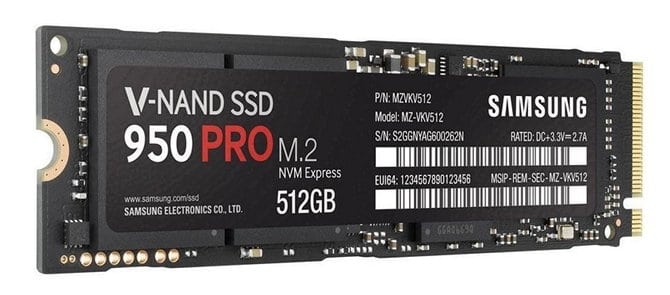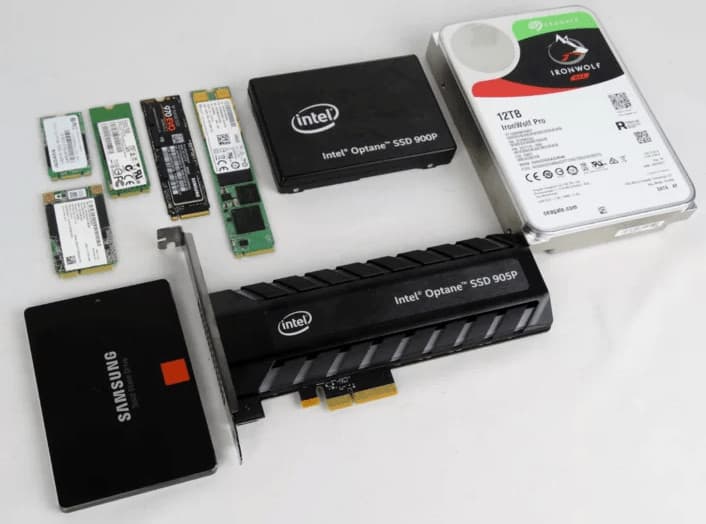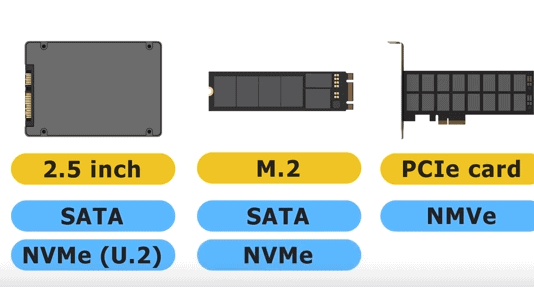PCIe SSDs may be technologically superior to the SATA SSD, but that doesn’t mean you should always prefer them when you go to buy an SSD. But why?
In this article, we’ll explain the differences between SATA and PCIe drives and what you need to know to decide when going to buy an SSD.
What are PCIe SSD tablets?
Why are PCIe SSD tablets always more desirable and more expensive than SATA SSD? Does it have anything to do with performance? Of course, i’m not going
PCIe is peripheral Component Interconnect Express’s shorthand and its translation is “quick connectivity of peripherals”, which is a way of direct data communication with the motherboard.
This binding method is commonly used with devices such as graphics processing cards that require a very fast data connection, but pcIe has also proven useful with data storage disks.
PCIe 3.0 has a transfer speed of 985 Mbps per track, and since PCIe devices can support communication over 1, 4, 8 or 16 tracks, we’re talking about transfer speeds of up to 15.76GB/s.
This means that a PCIe SSD with 16 tracks is 25 times faster than the SATA SSD! In theory. In practice, you won’t find SSD sds from the consumer market that have many data paths. Consumers are usually available for 2 or 4 routes, which means that the maximum transport speed you can get as a consumer is close to 3.94GB/s.
However, you will only notice the difference between PCIe and SATA when transferring bulky files that take some time. For example, if you’re playing a video game and you just want faster download speed when you start the game or change maps, you won’t feel the difference between pcie SSD and SATA SSD drives, both of which will work as lightning speed in this area.
PCIe SSDs make your computer’s battery life worse. If you’re just browsing the web, editing Office documents, or sending emails, you won’t notice a big difference between SATA and SSD PCIe performance (because such activities don’t involve a lot of data transfers). But if you’re constantly reading and transmitting data, SSD PCIe drives will use more power and drain battery life faster.
One last note regarding the AHCI vs. NVMe criteria. If you have to choose between these two criteria, choose NVMe because AHCI is older and is designed for SATA engines in the first place, which means that the PCIe SSD drive that uses AHCI will not work to its fullest. NVMe is specifically designed for use with PCIe so it works best.

What are sata SSD tablets?
SATA, or Serial ATA, is a type of connection used by SSS dMs to transmit data. This type was created in 2003, SATA hdd drives have better hardware compatibility. If you get an SATA SSD it is pretty much guaranteed to work with any desktop or laptop you have now – even if that computer is a decade old.
SATA drives with worse relative performance. At the time of writing, SATA 3.0 is the most widespread form of SSD discs with a theoretical transfer speed of 6 Gbps (750 Mbps). But the actual transfer speed is 4.8 Gbps (600 Mbps). While 600 Mbps is very fast, it is not close to the transport speeds provided by PCIe SSD drives.
However, SATA SSDs are more than fast enough for ordinary users, to show how fast the SATA SSD can transfer all of the CD’s entire CD in one second.
SATA hard drives tend to be cheaper. This is probably the most important point for most users. The truth is that the price difference between SATA and PCIe drives is very large – just as the price difference between HHD and SSDs was very large.
When comparing two SSD drives with the same capacity, the Price of The SATA SSD is about half the price of PCIe SSD. SATA engines are therefore more budget-friendly than PCIe engines.
What do we mean by M.2 and U.2?
These criteria determine the shape, dimensions, and layouts of the storage disk. M.2 and U.2 standards are used for both SATA and PCIe.
The M.2 is much more common, so if you have to choose between the two and you’re not sure what type your computer supports, M.2 is the safest option to choose. The U.2 standard is used primarily in Intel 750 Series SSD drives that you won’t find many other companies that use this standard.
In addition, PCIe drives with 4 paths are more common than those with two tracks and are not much more expensive.
Note: You can buy an adapter that converts the M.2 link to the U.2 link or vice versa.
What kind of thing is right for you? SATA or PCIe?
Well, now it’s time to buy an SSD. What do I choose? If you have a limited budget and don’t do daily operations that require moving large files all the time, the SATA type will be enough for you. If you frequently carry daily large file transfers, buy PCIe.
Both are more suitable for use in the M.2 format, and both SATA and PCIe hard drives are clearly better than HDD suppalone in terms of speed so both options are successful.







إترك رد